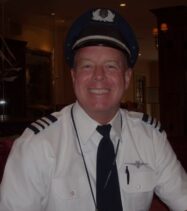“There is something on the scan.”
Six little words that hold so much meaning. These six words were followed by a non-emotional, young emergency room doctor asking if we wanted to know what they saw.
Being a two-time cancer survivor myself, I wanted to beg the doctor not to say another word and to allow us to hang on to those last moments of blissfully not knowing. However, my husband, American Airlines First Officer Thomas Christiansen, said he wanted to know.

“There are three lesions on your brain,” said the doctor. My husband turned to me and voiced his gratitude that he had not suffered a stroke, which is what he had feared. My heart broke twice in that cold, sterile room — once at what the doctor had told us and again that my love did not yet understand this diagnosis was worse than a stroke. It was a diagnosis that would relentlessly fight against every treatment we tried. It was a diagnosis that would be career-ending, and ultimately life-ending for my dear husband.
The cognitive challenges that had taken us to the hospital that day had been hidden for several weeks. My husband had been out of work with a sinus infection, and I started to notice that I was finishing his sentences because he wasn’t able to do so. He also was having trouble following our conversations. At first this was not too concerning. As we all know, pilots can be good at tuning others out when they want to. However, it continued, and I could tell something was just not right.
I encouraged (he would say nagged) my husband to go to the doctor. He refused because he was worried that the U.S. Federal Aviation Administration might pull his medical. He told me, “I can’t go in saying I am having cognitive challenges. I will never fly again.”
My husband worked hard to accomplish his dream of become a pilot. He put himself through flight school and took any flying job he could to build hours. As a talented aviator with more than 35 years of experience, he was not going to give that up easily.
Eventually, the symptoms could not be covered up or explained away any longer. On our last “normal” day, we had gone to Home Depot, a place my husband knew well. Not only did he have trouble parking the truck, but he was unable to find anything inside the store. His fear of a stroke — and of me crying in the middle of the store — finally led him to seek medical attention.
I remember the day so clearly: Dec. 28, 2019. As we walked through the hospital parking lot, I knew that our lives would never be the same. Walking into the hospital took every ounce of strength I had. That is, until I had to walk out alone without the love of my life just 10 months later.
At the hospital, things moved quickly. After a CT scan (computed tomography, a procedure that uses X-rays and computer technology to develop images of the inside of the body) showed the lesions, doctors started asking about my husband’s medical history. I began listing normal illnesses such as his recent sinus infection, previous kidney stones, cataracts, etc. My husband reminded me not to forget the melanoma he had 19 years earlier. At that point, every head in the room turned, and we all knew. The melanoma was back, and with a vengeance.
Most people think of melanoma as a simple skin cancer, assuming that if the mole is removed, the cancer is gone. When my husband was diagnosed in 2001 with a Stage 1 melanoma on his chest, that’s what we thought. At that time, no treatment was recommended for Stage 1 melanoma. Since he was a pilot, the FAA required brain scans and chest X-rays for five years. After that, he was considered cured, and we never gave that mole another thought — until that day in the emergency room.
Melanoma is much more prevalent in pilots than my husband or I ever realized. A study in JAMA Dermatology, published by the American Medical Association, found that flight crews have twice the incidence of melanoma than the general population. The time spent at higher altitudes; travel to tropical destinations, which are closer to both the equator and the sun; and interruptions to a crewmember’s circadian rhythms have all been cited as putting an individual at high risk for all types of skin cancer (“Higher Risk”).
Melanoma can remain dormant for many years, as was the case with my husband. It most frequently spreads to the brain and/or lungs (hence, the reason the FAA required brain scans and chest X-rays). Unfortunately, the spread of melanoma to other organs cannot be detected by a simple skin check. Once the signs begin showing, it often means the disease has progressed — the reason prevention and early detection is so important.
According to the MD Anderson Cancer Center in Houston, Texas, U.S., melanoma only accounts for 3 percent of skin cancers but is more likely than other skin cancers to metastasize to other parts of the body. Once it reaches the brain, the prognosis is poor.
My husband was ready for battle. The stubborn pilot in him was going to defy the odds. Brain surgery was followed by targeted therapy, but there were roadblocks everywhere. Each scan showed more progression of the disease, but we never thought that he would not beat it. He continually spoke of getting his medical back and finishing his last five years with American Airlines.
Sadly, my amazing husband lost his battle at age 61, in November 2020, 10 months after his diagnosis. My heart has been shattered, as have the hearts of our children. My husband should be here watching his daughter raise his little grandson. He should be here watching our son follow in his footsteps as a commercial pilot. So many things he still had left to do. So much life he still had to live.
This is the face of melanoma — my husband, American Airlines pilot Thomas Christiansen. To his fellow aviators, I encourage you to wear sunscreen every single day, especially when you are flying. See your dermatologist for regular skin checks. Don’t let the fear of losing your medical license keep you from doing so. Trust me when I say that melanoma is not just a simple mole that you remove. It can change lives in the blink of an eye.
Elise May is the senior program manager, inflight safety and regulatory compliance, at a major commercial airline.


